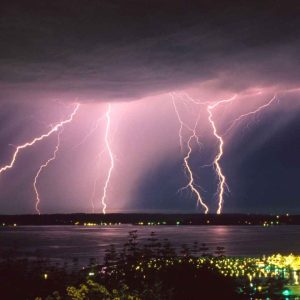What are the consequences of a direct lightning strike ?
Luminous:
This is the first consequence of a lightning strike due to the advantage of the speed of light over any other phenomenon.
Along the path of the tracers, superheated and ionized gases form a conductor plasma, which results in the emission of light that we observe and which is called “flashing”. The color of this flash depends on factors such as current density, viewing distance and the different particles present in the path of the tracer.
Acoustics:
Lightning is accompanied by an acoustic wave, thunder. This wave is generated by the sudden expansion of the air superheated by the electric arc. It may consist of a sharp noise or a dull rolling sound depending on the listening distance.
The duration of thunder depends on the size of the ionized channel.
Thermal:
These effects are linked to the quantities of charges brought into play during lightning strikes. They result in more or less significant melting points at the impact level when it comes to materials of high resistivity. On poorly conductor materials (construction materials other than metals), a large amount of energy is released in the form of heat; the humidity they contain then causes a sudden localized overpressure which can lead to their bursting.
Mechanical:
By releasing significant quantities of energy, the resistivities of the materials crossed come into play. Depending on these materials, we witness deformations, tearing, destruction and explosions.
Electrodynamics:
The proximity of metallic masses adjacent to the down conductors creates, when a lightning current passes, significant forces due to the magnetic attraction/repulsion phenomenon generated.
Electrochemical:
An electrolytic reaction in materials (chemical decomposition) is likely to be generated, however the ephemeral nature of the lightning current makes it a negligible phenomenon.
Electronics:
The electrical nature of the phenomenon and the resistivity of the soil leads to the propagation of lightning current in concentric waves in the ground and on the surface. The rise in potential of the surrounding masses leads to significant currents, resulting in dangerous current rises from the metal masses subjected.
Proximity voltage:
During the dissipation of current in the ground, a phenomenon called step voltage can occur on living beings. It causes burns, respiratory arrests, cardiac arrests, etc. It is due to the propagation of currents by contact with the being on the ground.

